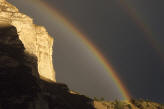|
|
Glacier National Park, located in northern Montana, features over one
million acres of rugged mountain beauty. As its name implies, several small glaciers
are found within the park's boundaries. Glacier was established in 1910 as a
national park and currently attracts roughly two million visitors per year to its
snow-clad mountains and deep valleys.
Glacier preserves over 1,000,000 acres of forests,
alpine meadows, and lakes. Its diverse habitats are home to over 70
species of mammals and over 260 species of birds. The spectacular
glaciated landscape is a hikers paradise containing 700 miles of
maintained trails that lead deep into one of the largest intact ecosystems
in the lower 48 states.
The park contains over 350 structures listed on
the National Register of Historic Sites and six National Historic
Landmarks.
In 1932 Glacier and Waterton Lakes National Park,
in Canada, were designated Waterton-Glacier International Peace Park. This
designation celebrates the longstanding peace and friendship between our
two nations. Glacier and Waterton Lakes have both been designated as
Biosphere Reserves and together were recognized, in 1995, as a World
Heritage Site.
Popular summer activities include hiking, wildlife viewing, photography,
biking, camping, horseback outings, boating, fishing, sightseeing and backpacking.
Some activities do cost extra.
Popular summer spots in Glacier include the Logan Pass Visitor Center, the
Many Glacier area, the Lake McDonald Valley, and the famous Going-to-the-Sun Road which
bisects the heart of the park on a fifty mile trek.
Visitors should be aware that there are size restrictions on the
Going-to-the-Sun Road. Vehicles longer than 21 feet or wider than 8 feet (including
mirrors) are prohibited on the steepest sections of the road.
Glacier is known for having a high density of grizzly bears.
Also, there are numerous gift shops, camp stores and restaurants inside
the park.
|

